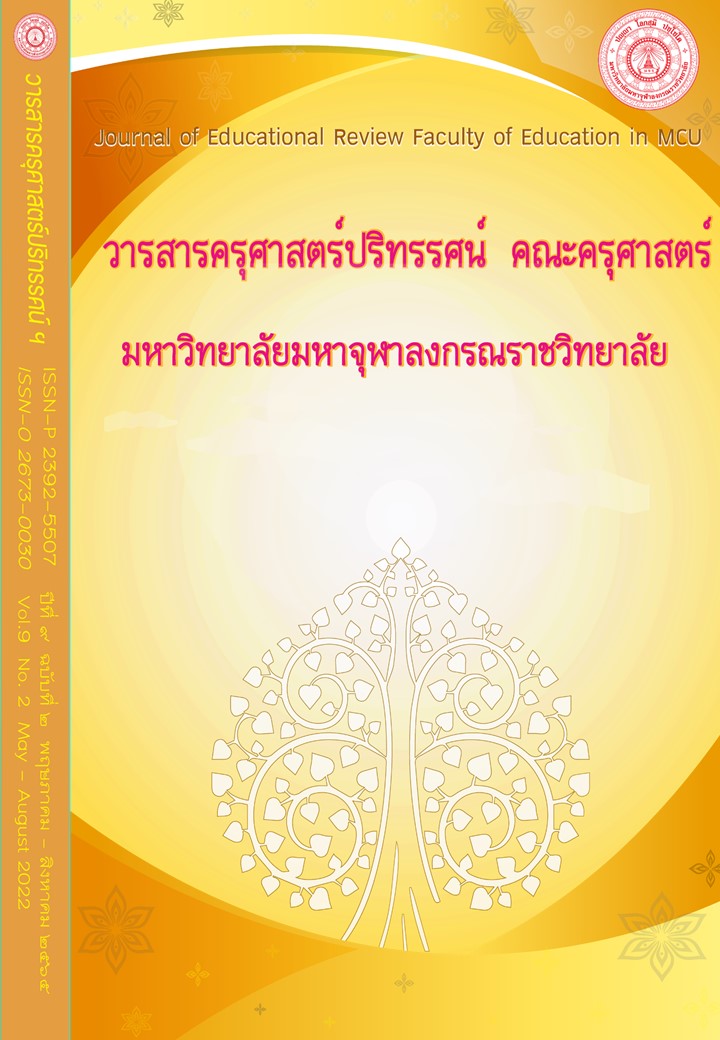THE STUDY OF TEACHER IMMEDIACY BEHAVIORS AND ITS IMPACT ON STUDENTS’ ATTITUDE IN ENGLISH AS A FOREIGN LANGUAGE (EFL) SECONDARY CLASS
Main Article Content
Abstract
This study aimed to compare the relation between teacher immediacy behaviors and students’ attitude toward learning English. Study students’ and English teachers’ opinions toward teacher immediacy behaviors and also students’ attitude toward learning English by classifying related factors. The samples were 1,700 students and 330 English teachers in schools under the Bangkok Metropolitan, the Office of Secondary Educational Service Area 1 and Area 2. Multi-stage Sampling was used. Research tools for this study were online questionnaires for the students with 72 items and for the teachers with 42 items. The data were analyzed by mean, standard deviation, percentage, frequency, Pearson’s product moment correlation, one-way analysis of variance, T-test (Independent), Scheffe’s test and LSD test. The results showed that students’ opinion as well as English teachers’ opinion toward teacher immediacy behaviors were at ‘high’ level. While only students’ attitude toward learning English is at ‘moderate’ level. It is to say that there was significant positive correlation between teacher immediacy behaviors and students’ attitude in learning English at a .05 significance level. Gender, age, and school size are factors that affected students’ opinion toward teacher immediacy behaviors while gender, age, English grade point average, school size, and school cluster affected students’ attitude toward learning English. Meanwhile, factors that affected teachers’ opinion included gender, and school size.
Article Details

This work is licensed under a Creative Commons Attribution-NonCommercial-NoDerivatives 4.0 International License.
ทัศนะและความคิดเห็นที่ปรากฏในบทความในวารสารฉบับนี้ถือเป็นความรับผิดชอบของผู้เขียนบทความนั้นเพียงผู้เดียว และไม่ถือเป็นทัศนะและความรับผิดชอบของกองบรรณาธิการ
กองบรรณาธิการขอสงวนสิทธิ์ในการคัดเลือกบทความลงตีพิมพ์และจะแจ้งให้เจ้าของบทความทราบหลังจากผู้ประเมินบทความตรวจอ่านบทความแล้ว
ต้นฉบับที่ได้รับการตีพิมพ์ในวารสารครุศาสตร์ปริทรรศน์ คณะครุศาสตร์ มหาวิทยาลัยมหาจุฬาลงกรณราชวิทยาลัย ถือเป็นกรรมสิทธิ์ของคณะครุศาสตร์ มหาวิทยาลัยมหาจุฬาลงกรณราชวิทยาลัย ห้ามนำข้อความทั้งหมดหรือบางส่วนไปพิมพ์ซ้ำ เว้นเสียแต่ว่าจะได้รับอนุญาตจากมหาวิทยาลัยฯ เป็นลายลักษณ์อักษร
References
บรรเจิด พฤฒารัตน์. (2564). ความคิดเห็นเกี่ยวกับการสอนวิชาภาษาอังกฤษจากประสบการณ์ในการทำอาชีพครู. (พิชญาอร ผลดี, ผู้สัมภาษณ์). (20 ส.ค. 2564).
มรกต ศรียาสวิน. (2545). ตัวแปรที่เกี่ยวข้องกับแรงจูงใจใฝ่สัมฤทธิ์ในการเรียนวิชาดนตรี-นาฏศิลป์ของนักเรียนชั้นประถมศึกษาปีที่ 5 โรงเรียนเซนต์โยเซฟคอนแวนต์ กรุงเทพมหานคร. วิทยานิพนธ์การศึกษามหาบัณฑิต. มหาวิทยาลัยศรีนครินทรวิโรฒ.
Baker M. (2010). Understanding Motivation: A Review of Relevant Literature. Carleton Papers in Applied Language Studies. 21(22). 71-116.
Hawes, L. C. (1973). Elements of a model for communication processes. Quarterly Journal of Speech. 59(1). 11-21.
Kirova et al. (2012). Investigation of Motivation and Anxiety in Macedonia While Learning English as a Second/Foreign Language. Procedia-Social and Behavioral Sciences. 46. 3477-3481.
LeFebvre, L. and Allen, M. (2014). Teacher immediacy and student learning: An examination of lecture/laboratory and self-contained course sections. Journal of the Scholarship of Teaching and Learning. 14(2). 29-45.
McLemore, M. and Cunningham, J. (1994). Teacher Immediacy Behavior: Student Learning Outcomes and Evaluation. Second Annual College of Continuing Education Faculty Symposium on Teaching Effectiveness.
Mehrabian, A. (1969). Some referents and measures of nonverbal behavior. Behavioral Research Methods and Instrumentation. 1. 213-217.
Mullane, R. Rebecca. (2014). Student's Perception of Teacher Immediacy Behaviors on Student Success and Retention. Doctor of Philosophy in Communication. Wisconsin: University of Wisconsin-Milwaukee.
Rahimi, M. and F. H. Karkami. (2015). The role of teachers’ classroom discipline in their teaching effectiveness and students’ language learning motivation and achievement: A path method. Iranian Journal of Language Teaching Research. 3(1). 57-82.
Richmond, V. P., Gorham, J. S., & McCroskey, C. (1987). The relationship between selected immediacy behaviors and cognitive learning. M. L. Mclaughlin (Ed.). Newbury Park, CA: SAGE.


